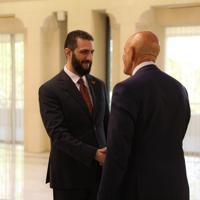The Complex Dynamics of the Syrian Conflict: A Close Look at Recent Developments
In the ever-evolving landscape of the Syrian conflict, recent meetings have highlighted the intricate negotiations surrounding the relationship between the Syrian Democratic Forces (SDF) and the Syrian government. U.S. envoy for Syria, Tom Barrack, has emphasized that the path to resolution necessitates more robust discussions and faster action. His observations provide a revealing snapshot of the complexities involved in integrating diverse military factions within a historically fraught political landscape.
Sluggish Negotiations and Urgency for Change
Tom Barrack’s critique of the SDF’s slow pace in negotiations with the Syrian government illustrates a pressing concern for both American officials and regional stakeholders. During discussions about the integration agreement first struck in March 2023, Barrack underscored the importance of speed in decision-making processes. His advice to the SDF is simple yet poignant: acceleration is essential for progress. There’s a clear urgency for the SDF to move beyond hesitations and engage more decisively with the Syrian regime, signaling that inertia could lead to more significant challenges ahead.
The Road to Damascus: Symbolic and Literal
Barrack’s statement that “there is only one road and that road is to Damascus” encapsulates the centrality of the Syrian capital in the country’s political dynamics. This phrase not only reflects the geopolitical reality but also serves as a metaphorical reminder that all paths of negotiation and potential reconciliation lead to the heart of the Syrian state. The emphasis on Damascus as the focal point for discussions implies that any meaningful resolution must occur within the structures and authority of the Syrian government.
The Stalemate: Integration Challenges
Despite the urgency expressed, significant barriers remain between the SDF and the Damascus regime. The July 9 meeting between Syrian President Ahmad al-Sharaa and SDF leader Mazloum Abdi, attended by Barrack and a French representative, revealed persistent differences over the integration discussion. Although both parties aim for a resolution, the foundational agreements have been thwarted by a lack of consensus, particularly regarding governance structures.
Federalism: A Touchy Subject
A critical point of contention is the SDF’s demand for federalism, which Barrack rejected outright. This assertion raises crucial questions about governance and autonomy in a region that has long grappled with issues of identity and political representation. Barrack posited that the notion of independent non-state entities coexisting within a unified national framework is fundamentally flawed, painting a stark picture of federalism’s viability in the region.
Trust-Building: The Key to Progress
Barrack’s emphasis on the need for trust-building between the once-adversarial parties underscores the intricacies of political reconciliation in a divided nation. His observation that progress will come in "baby steps" highlights the tempered nature of negotiations, which rely heavily on mutual commitments and understanding. Steps toward reconciliation will require patience and a gradual easing of historical tensions, an approach that resonates deeply with the broader narrative of conflict resolution.
Cohesion vs. Integration: Diverging Visions
One of the primary sticking points in discussions centers around the future of the SDF as a military entity. The question remains whether the SDF will maintain its cohesion as an organized unit within the new military framework or if its forces will be dissolved into a more traditional military structure. The outcome of this debate could define the very nature of security and representation for Kurdish communities in Syria, making it a pivotal aspect of the ongoing dialogue.
Conclusion: Ongoing Complexity
As the situation in Syria unfolds, the delicate dance of diplomacy continues to navigate a turbulent political landscape. With both U.S. interests and regional dynamics at play, the path forward remains fraught with complexity and uncertainty. The interactions between the SDF and the Syrian government symbolize not just a search for stability in Syria, but a broader struggle for identity, governance, and peace in a region marked by decades of conflict.


